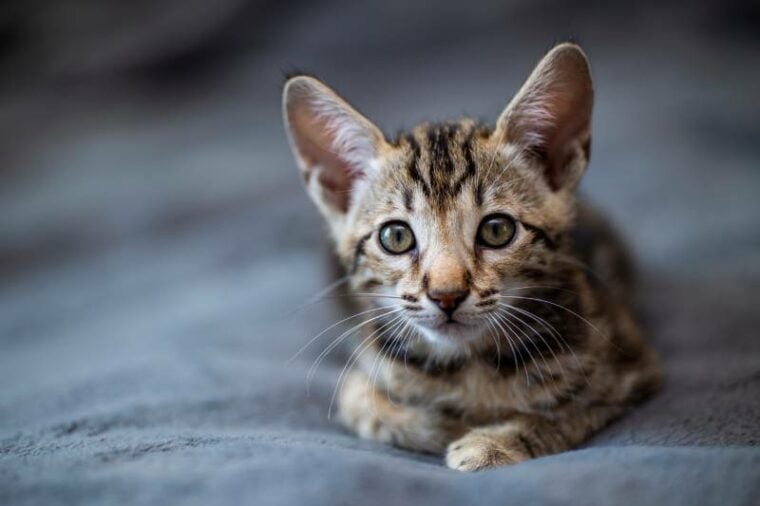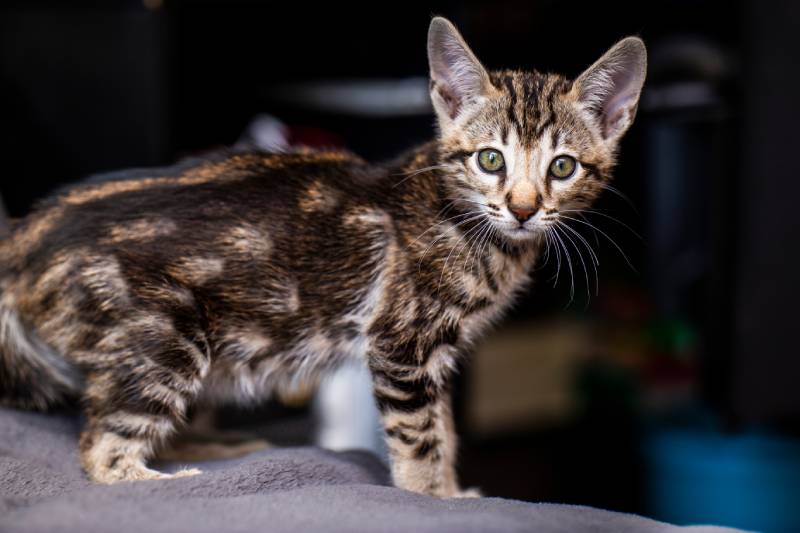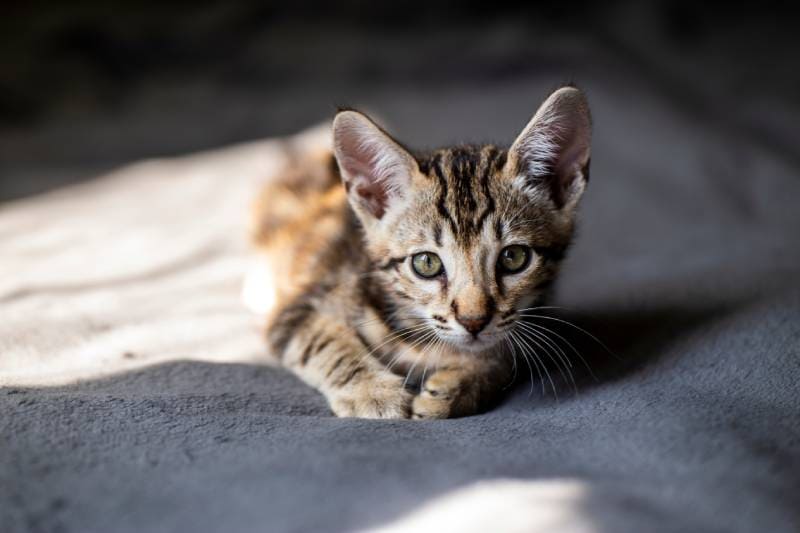
Click to Skip Ahead
The Savannah is a truly special breed of cat. Not only do they have a whole set of distinctive, exotic features and vivacious personalities, but these cats also have a very unique heritage.
Savannah cats are created by breeding a domestic cat with an African Serval, and there are several different types (Filial Designation) depending on how much Serval blood they have. In short, F1 Savannahs are first-generation, which means they’re the type of Savannah most similar to wild Servals with between 50% and 75% Serval blood.
F4 Savannah cats have around 10 to 20% Serval blood and are produced by breeding between an F3 Savannah female and Savannah male. In this post, we’ll take a closer look at F4 Savannah cats, their traits, and their history.
Breed Overview
Height:
10–16 inches
Weight:
10–20 pounds
Lifespan:
12–20 years
Colors:
Black, brown spotted tabby, black silver spotted tabby, black smoke
Suitable for:
Any loving home, including families with children
Temperament:
Loyal, friendly, companionable, active, inquisitive
Male Savannah F4s in particular can get pretty big, and typically stand between 14 and 16 inches at the shoulder and weigh between 14 and 20 pounds, though they’re still smaller than F1 and F2 Savannahs. Female F4s are likely to be a little smaller and lighter than males.
Savannah cats have a true air of elegance with their tall, slender bodies, long legs, large, pointed ears, and chiseled facial features.
F4 Savannah Cat Breed Characteristics
The Earliest Records of F4 Savannah Cats in History
The Savannah cat is a very modern breed and first came about in 1986 with the birth of the first F1 Savannah cat on April 7 of that year. The first Savannah cat was born of a female domestic cat owned by Judee Frank and an African Serval and was named “Savannah”.
It was noted that Savannah had a very unique combination of traits—the characteristics of a standard domestic cat coupled with some African Serval traits.
Savannah was responsible for producing the first litter of F2 Savannah cats and continued to have more litters throughout her lifetime. These F2 kittens were bred by a woman named Suzi Wood, who took over ownership of Savannah.

How F4 Savannah Cats Gained Popularity
In the 1980s, a breeder called Patrick Kelley heard about Savannah the domestic cat-African Serval hybrid, and reached out to Suzi Wood and Judee Frank, hoping to start a breeding program. Wood and Frank declined to continue developing the breed, so Patrick Kelley bought one of Savannah’s female kittens to start his own breeding program.
After a great deal of persuasion on Patrick Kelley’s part, he managed to join up with Joyce Sroufe, a fellow breeder, and the Savannah cat’s development continued. Joyce Sroufe is credited with having contributed massively to the breed’s development. Sroufe first showed Savannahs at a 1997 New York cat show, which brought the breed into the public eye.
Formal Recognition of F4 Savannah Cats
The Savannah received official recognition from the International Cat Association (TICA) in 2001. TICA remains the only official association to recognize the Savannah. The Cat Fanciers’ Association (CFA) does not recognize the Savannah cat as an official breed since it does not support crossing domestic cats with wild/non-domestic cats.
According to TICA’s breed standard, the Savannah is a “tall, lean, graceful cat” that “closely resembles its ancestral source, the African Serval, but is smaller in stature”. Their markings are described as “bold” and can sit atop a brown, silver, black, or black smoke background.
TICA penalizes Savannah cats with rosettes or spots that do not fall within the dark brown to black standard. Small ears, a “cobby” body, lockets in non-standard areas, and stripes that resemble those of a mackerel tabby are also penalized. Extra toes are grounds for disqualification.
Top 3 Unique Facts About F4 Savannah Cats
1. F4 Savannah Cats Can Cost up to $10,000
Savannah cats are incredibly expensive to buy. One Savannah breeder advertises its F4 Savannah cats as costing between $3,000 and $9,000 each. Earlier generations, like F1 and F2s, are even more expensive and can cost up to $20,000.
2. F4 Savannah Cats Have a Lot of Energy
If you acquire an F4 Savannah, be prepared for them to expend lots of energy climbing, playing, and jumping—some of their favorite activities. Though they have less Serval blood than earlier generations like F1s and F2s, F4 Savannahs are still quite the livewires.
3. Savannah Cats Are Incredible Jumpers
One of the coolest traits Savannah cats have inherited from their wild ancestors is the ability to jump rather high. They love jumping and climbing, so be sure to provide plenty of climbing spots for your Savannah.

Does an F4 Savannah Cat Make a Good Pet?
By all accounts, F4 Savannah cats make great companions for the whole family thanks to their friendliness, loyalty, and sociable, extroverted personalities. They’re also really smart, which makes them easy to train and quick to learn.
According to one F4 Savannah breeder, owners have reported that some F4 Savannahs are smart enough to learn how to open doors and disassemble objects like toys, so you might want to watch out for these habits if there are certain areas and objects you’d like your cat to stay away from!
In spite of their wild blood, F4 Savannahs are known for being very companionable and affectionate with their families as a rule, though they can be a little more aloof and reserved around strangers.
They may not be suitable for homes with small animals like rodents and birds. This is because, though some cats learn to get along with small animals, Savannahs have a famously strong prey drive and can be prone to being territorial, it is probably just not worth the risk.
Conclusion
In brief, F4 is one of the Filial Designation codes given to Savannah cats based on their generation. While F1 and F2 Savannah cats are more closely linked to their wild descendants, F4s are smaller, lighter, and are a little more like domestic cats in terms of appearance.
Their outgoing and sociable personalities make them the ideal family cats, though they do have a great deal of energy and will need plenty of mental and physical stimulation to keep them out of trouble!
Featured Image Credit: Kolomenskaya Kseniya, Shutterstock






